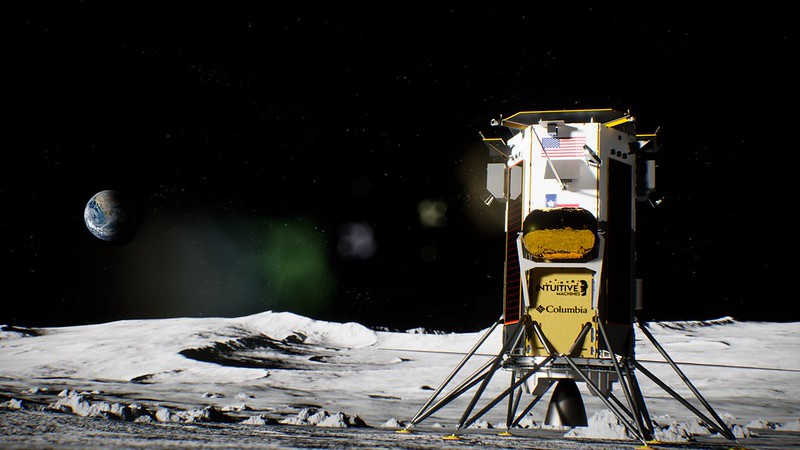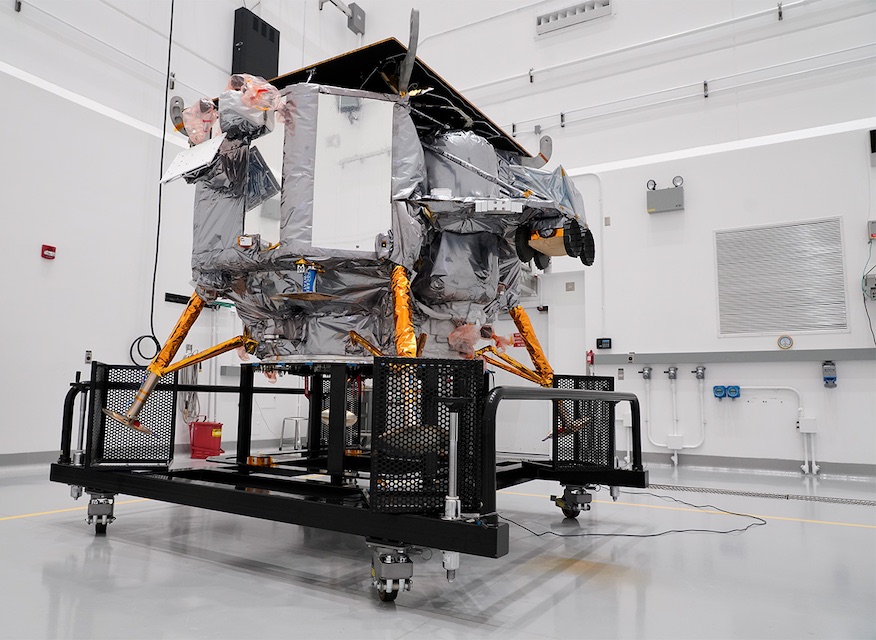Space News & Blog Articles
Three robotic missions target Moon landings over one week in January
 Intuitive Machines engineers loading the IM-1 mission Nova-C lunar lander into its custom container in Houston, TX. Image: Intuitive Machines
Intuitive Machines engineers loading the IM-1 mission Nova-C lunar lander into its custom container in Houston, TX. Image: Intuitive Machines
In a blend of interesting circumstances and happenstance, two private companies and Japan’s space agency are all poised to land on the Moon in the back half of January 2024.
The Japanese Aerospace Exploration Agency (JAXA), Astrobotic and Intuitive Machines are all exercising distinct launch and landing options to reach the lunar surface. But all three have announced timelines that would see them land on the Moon within days of each other, if everything stays on track at this point.
While avoiding further timeline slipping is far from a certainty, Earth’s satellite could see its busiest month ever in terms of new spacecraft arriving.
As it happens, the last lander scheduled to launch could be the first to touch down on the Moon. Intuitive Machine’s Nova-C lander is targeting liftoff between Jan. 12-16 and is set to land at the Moon’s South Pole (80.297°S, 1.2613°E) on either Jan. 19 or 21.
A spokesperson for Intuitive Machines said the landing opportunity for both days is in the afternoon in EST.
Trent Martin, the Vice President of Lunar Access at Intuitive Machines, told Spaceflight Now in an Oct. 27 interview that they have instantaneous launch opportunities each day during their January window. He said because their lander needs to be fueled at the launch pad, crews will perform a wet dress rehearsal several days ahead of launch.
“We will do a full fuel of our vehicle to ensure that we have the timeline down because we do a late fueling at the pad. We fuel with liquid oxygen and liquid methane, and we want to fuel as late as possible,” Martin said. “SpaceX has been very accommodating and they’re providing us a service that gives us liquid oxygen, liquid methane. They’ll fill up until the very last minute so that we’re as full as possible, so that we have the highest chance of success at landing on the Moon.”
 A rendering of Intuitive Machines’ Nova-C lander on the Moon’s surface. Image: Intuitive Machines
A rendering of Intuitive Machines’ Nova-C lander on the Moon’s surface. Image: Intuitive Machines
This mission along with the Peregrine lander will mark the first two fulfilled contracts under NASA’s Commercial Lunar Payload Services (CLPS) program.
Onboard the Nova-C lander for NASA are the following:
Navigation Doppler Lidar (NDL) Lunar Node-1 (LN-1) Lunar Retroreflector Assembly (LRA) Stereo Cameras for Lunar Plume Surface Studies (SCALPSS) Radio wave Observations at Lunar Surface of photo Electron Sheath (ROLSES)This mission also features a CubeSat payload called EagleCam from Embry-Riddle Aeronautical University, which will be launched from the lander when it’s about 30 meters above the surface.
“The camera itself is actually multiple cameras, four cameras. So as this 1U CubeSat tumbles, it’s taking video imagery as it falls to the surface. And so from that, within a day or two, we’ll have video of us landing on the Moon,” Martin said. “So, I’m super excited about that one because that will be the first time that anyone’s ever actually recorded themselves landing on another planetary body.”
Intuitive Machines announced on Monday that its Nova-C lander for the IM-1 mission arrived at the Cape in Florida ahead of its launch next month.
Double landing possibility
JAXA’s Smart Lander for Investigating Moon (SLIM) is spending the longest in space, having launched back on Sept. 7, but depending on the timing of the IM-1 landing, it could touch down on the same day from a Coordinated Universal Time (UTC) standpoint.
According to a statement from JAXA on Tuesday, SLIM is set to begin its descent to the lunar surface at 12:00 a.m. JST on Jan. 20 (1500 UTC on Jan. 19) and touchdown at 12:20 a.m. JST (1520 UTC).
 SLIM (Smart Lander for Investigating Moon) aims to demonstrate “landing where it is desire to land”, pin-point landing technique and obstacle detection technique. Graphic: JAXA
SLIM (Smart Lander for Investigating Moon) aims to demonstrate “landing where it is desire to land”, pin-point landing technique and obstacle detection technique. Graphic: JAXA
The next big milestone in SLIM’s journey is coming up on Dec. 25 when it enters into lunar orbit. JAXA stated that the 200kg dry mass (700kg wet mass) lander will achieve a “full” degree of success if it is able to land within a 100-square-meter target using its “vision-based navigation” system.
The target landing site for SLIM is the SHIOLI crater near the “Sea of Nectar,” located at 13.3°S, 25.2°E. The lander is designed to operate until lunar sunset occurs.
Its payloads include the Multi-Band Spectral Camera (MBC), which will examine the composition of surrounding rocks, and a small probe called the Lunar Excursion Vehicle 2 (LEV-2), “which separates from the main spacecraft just before landing and performs photo imaging.”
“To satisfy the limited size of the vehicle to be [mounted] on SLIM, we had to downsize LEV-2. However, downsizing causes a decrease in running performance,” said Hirano Daichi, one of the researchers involved with LEV-2, in a statement. “In order to deal with this problem, we designed the vehicle to be a spherical object with expandable wheels and a stabilizer using the transforming technologies for toys.”
“Moreover, we adopted the robust and safe design technology for children’s toys, which reduced the number of components used in the vehicle as much as possible and increased its reliability,” he added.
 A graphic illustrating the landing sequence for SLIM. Graphic: JAXA
A graphic illustrating the landing sequence for SLIM. Graphic: JAXA
Peregrine takes flight soon
The next lander to launch and the last one scheduled to land in January is Astrobotic’s Peregrine lunar lander. Liftoff aboard a United Launch Alliance Vulcan rocket is set for 1:49 a.m. EST (0649 UTC) on Dec. 24. If needed, there are backup opportunities at 1:53 a.m. EST (0653 UTC) on Dec. 25 and 2:08 a.m. EST (0708 UTC) on Dec. 26.
The mission will launch the lander on a translunar injection.
 Astrobotic’s Peregrine lunar lander in the clean room at Astrotech in Titusville, Florida. The spacecraft will be the main payload onboard the first launch of ULA’s Vulcan rocket. Image: ULA
Astrobotic’s Peregrine lunar lander in the clean room at Astrotech in Titusville, Florida. The spacecraft will be the main payload onboard the first launch of ULA’s Vulcan rocket. Image: ULA
“We will be close to Earth, but on a trajectory that will more or less intersect with the Moon’s orbit. It’s at that point, and this is within about an hour or so of launch, we’re going to separate from the launch vehicle and our lander and Astrobotic’s mission begins,” said John Thornton, Astrobotic CEO, during a media teleconference on Nov. 29.
According to a Nov. 14 presentation by Dr. Joel Kearns, NASA Deputy Associate Administrator for Exploration, the landing window for the Peregrine Mission-1 landing is at 3:30 a.m. EST (0830 am UTC) on Jan. 25.
Once they land, Thornton said Peregrine will operate for about 10 days at which point the Sun will set on that part of the Moon, after which he said it will likely become to cold to operate.
“In time, we are developing capability to survive that night, but on these first missions, we’re really focused on the hard enough problem, which is landing on the Moon in the first place,” he said.
As with the IM-1 mission, PM-1 will also host a slate of NASA payloads as a participant in the CLPS program. During the teleconference, Thornton said he mostly only thinks about the other companies trying to land on the Moon when asked about it by press, adding that many players are needed for the lunar economy to be a successful venture.
“We need this industry to succeed. We need the CLPS program to succeed. That is the number one priority for us,” Thornton said. “Of course, there is some level of competition with our competitors, but at the end of the day, it’s really secondary. The most important is the industry and most important is landing success.”
 An illustration of the mission path for Astrobotic’s Peregrine Mission-1. Graphic: NASA
An illustration of the mission path for Astrobotic’s Peregrine Mission-1. Graphic: NASA
When you subscribe to the SpaceZE News Feed, we will send you an e-mail when there are new updates on the site so you wouldn't miss them.

